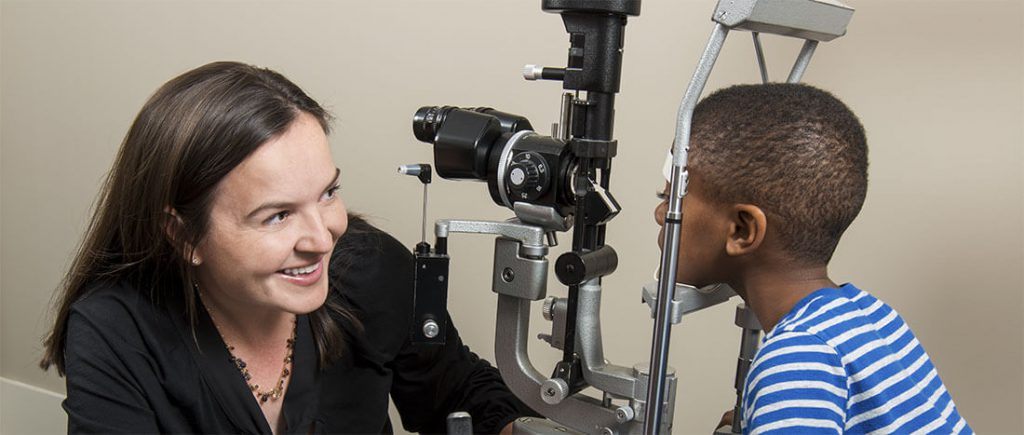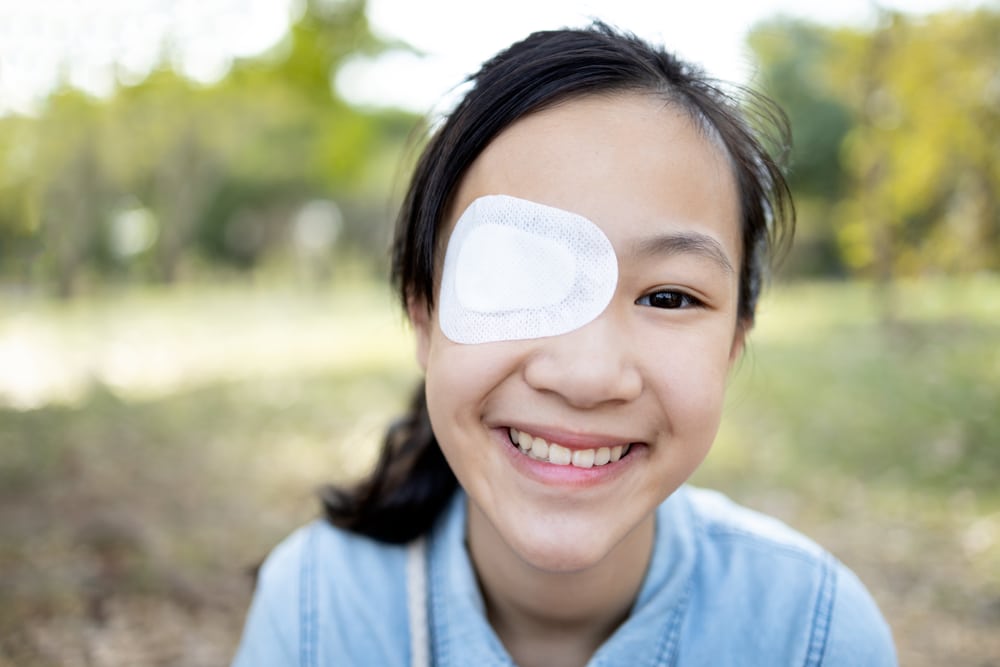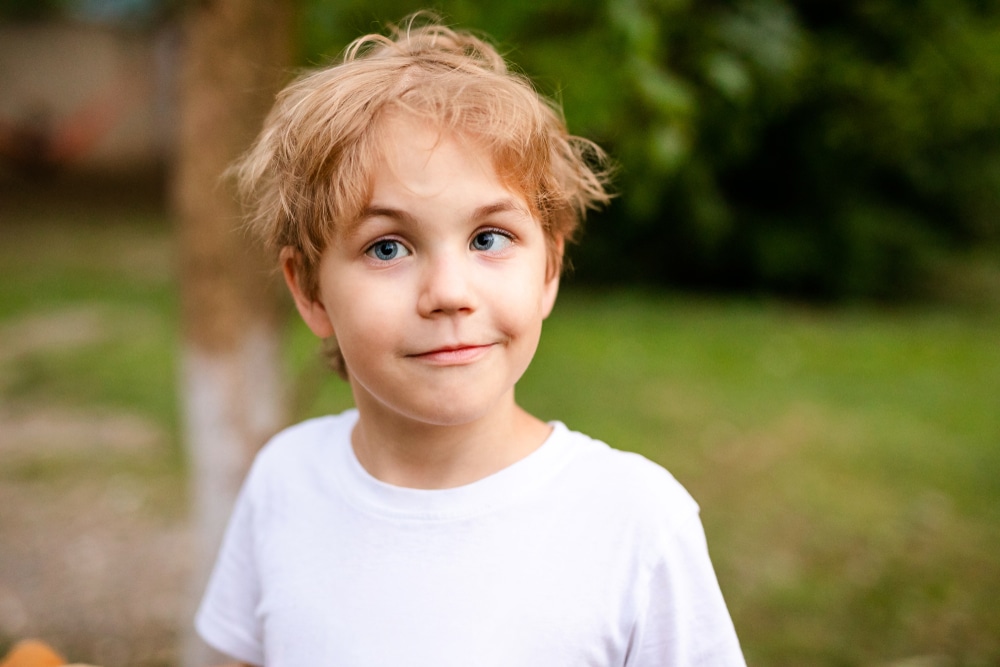Vision problems in children are uncommon. But when they do occur, they often go undetected. Young children may not realize or be able to communicate that their vision is impaired. Even older children may not notice if the vision in only one eye is affected.
About 80% of what children understand is learned through their vision. Undetected vision problems can interfere with their learning and success at school. For these reasons, annual eye exams are just as important for children as for adults.

Every newborn undergoes a brief eye exam shortly after birth, mainly to ensure that no birth defects of the eye are present. This is usually performed by a pediatrician, family physician, nurse practitioner, or a physician’s assistant. A similar eye exam should take place between six and 12 months of age, usually during a well-child check-up with a pediatrician or family physician.
A primary goal of this second eye exam is to ensure that light can enter the eye unobstructed, so that vision will develop normally. This is evaluated by shining a light into the eye and observing a red or orange glow, called a red reflex, in the pupil of the eye — similar to the red eye often seen in photographs taken using a flash. Any problems that prevent light from entering the eye — such as extreme farsightedness, crossed eyes, or even a cataract — can prevent normal vision development, a condition called amblyopia, or lazy eye.
Once a child reaches age 3, and certainly by the age of 5, a vision screening should take place to make sure that vision is developing normally. Children in this age group are preparing to enter pre-school or kindergarten, and this examination is a good check for school readiness.
This eye examination should be done by an optometrist or ophthalmologist. Most children this age cannot read the letters on the eye chart, but special vision-testing charts — including some with easy-to-recognize pictures — are available. Because the development of good vision is vulnerable to amblyopia (sometimes called ‘lazy eye’) in this age group, a formal examination is very important by 3 years of age.
Some children in this age group have high degrees of nearsightedness or farsightedness, and need glasses to help their vision develop normally.
If all of the eye exams through to age 5 are normal, it is still necessary to have routine screening eye exams before first grade and every two years thereafter until age 18. Most children will undergo one or more vision screenings in elementary school, providing additional opportunities to identify vision problems. If a vision problem is detected, then it is important to comply with either annual eye exams or as frequently as recommended by the eye specialist.
In some cases, these screenings may consist of a special photograph that can identify children who are nearsighted, farsighted, or both, or who have misaligned eyes (called strabismus). All of these conditions can cause amblyopia, which can be treated if it is identified during the critical vision development period that lasts until children are about 10 years old. A routine eye examination is recommended in the mid-teens to ensure that vision is adequate to begin driving.
For more information on children’s eye screening, please visit https://www.aao.org/eye-health/tips-prevention/children-eye-screening.
Babies are not born with perfect vision. Normal vision develops slowly over the first several years of life. The eye and the brain together learn how to see over the first few years of life. And like a muscle, vision only grows if it is used. If for any reason the brain does not receive a clear image through an eye, that eye will never learn to see clearly. If sight does not develop normally, this is called amblyopia, or lazy eye.
Lazy eye can be caused by a number of common childhood eye conditions. If children are extremely nearsighted or farsighted, both eyes will be constantly blurred and both may become lazy. Some children have one eye that is more nearsighted or farsighted than the other, and can develop amblyopia in just the one eye.

Treating lazy eye depends in part on the cause of the amblyopia. The first step is to fix the cause. For more common causes, glasses can correct nearsightedness or farsightedness, and eye muscle surgery can re-align misaligned eyes. For the less common causes, droopy eyelids can be tucked and cataracts can be removed.
Once the cause of amblyopia is fixed, the lost vision in the lazy eye must be regained.
This is often accomplished by patching the good eye for brief periods, or blurring the vision in the good eye with special eye drops. Patching or blurring the good eye forces the lazy eye to work harder, so that vision in the lazy eye catches up to vision in the good eye.

Another common childhood eye condition that can cause lazy eye is ocular misalignment, also called strabismus. This is a condition in which the two eyes are looking in different directions. This may look like crossed eyes if the misaligned eye points inward, or wall eyes if the misaligned eye points outward. In either case, only one eye at a time is looking where the child wants to look, and to avoid double vision, the brain ignores the vision coming through the misaligned eye. If this vision is ignored long enough, lazy eye can develop in the misaligned eye.
Some uncommon causes of lazy eye are conditions that block vision from entering the eye, such as a droopy eyelid or a cataract. These are uncommon in children, but do happen to some children.
A lazy eye can be treated to restore normal vision. But it has to be diagnosed in order to be treated, and timing is very important. If a lazy eye is not diagnosed and treated by the age of nine or 10, the vision loss becomes permanent.